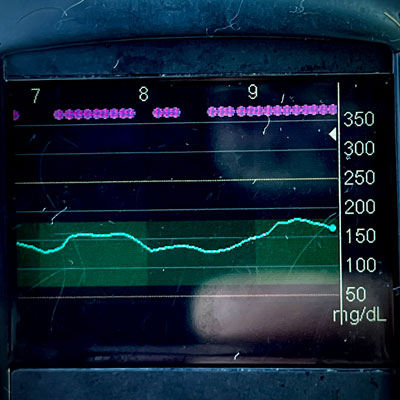Running Diabetes: What is going on with fueling?
As a runner, we all know that this sport of putting one step in front of the other brings challenges, some mental and some physical, especially for long-distance running. But the diabetic runner has additional variables and challenges to consider and deal with in addition to the already crazy sport. At the same time, the body is constantly using carbs (Glycogen), fat, and protein; the body normally regulates insulin secretion based on the consumption of fuel to keep the levels in a healthy range. The ratios and consumption of that fuel and insulin may vary per individual and the type of activity and effort.
I want to take a moment and talk a little bit about the relationship between sugars, glycogen, and performance. I will cover a few general things that apply to all runners and sprinkle here and there a few things for the diabetic runner to consider.
Insulin, Glycogen, and ATP are essential energy sources for the body. All three play in balance to provide the necessary energy source for the muscles to activate. Insulin is a hormone that helps to regulate the metabolism of carbohydrates, fats, and proteins. Insulin is produced and released in the pancreas in response to rising blood sugar levels. Keeping the glucose level in an optimal range. That optimal range allows the runner to feel “ok” or “Normal” while performing.
DIABETIC RUNNER: This is one of the key things that offer the 1st level of challenges to a diabetic runner. A diabetic either does not produce any insulin, produces very little or not enough, or the body has gotten into a state where it can’t utilize the produced insulin effectively. The latter is known as insulin resistance.
Glycogen is formed when glucose molecules are linked with a glucagon hormone. Glycogen is an important source of energy for athletes and runners, as it is the main storage form of carbohydrates in the human body. It plays a crucial role in providing energy for muscle contraction during running. It is created from the consumed food and helps us maintain our energy levels throughout the day. Glycogen is stored in the muscles and liver and can be used during exercise, such as running. Generally, the body can store enough glycogen to fuel most activities for 90-120 minutes.
As for glucagon, it is, in addition to insulin, another hormone produced by the pancreas that helps regulate blood sugar levels. Glucagon is released when food is consumed and helps to convert stored energy into glucose, which can be used for energy.
The relationship between glycogen, glucagon, and insulin is essential for optimal running performance since they play a key role in providing energy to athletes during physical activity. Without adequate levels of these hormones, athletes would not be able to maintain their performance levels over long periods of time or even during intense exercise.
On the other hand, ATP (Adenosine triphosphate) is another compound that is key to driving many processes in living cells, such as muscle contraction and nerve impulse propagation. In a nutshell, the ratio of glycogen to ATP measures the body’s energy reserves and how much is available during physical activity. When glycogen is broken down into parts, it releases glucose which can then be used to create ATP. This process allows cells to use glycogen as an energy reserve when needed, allowing them to maintain their normal functions even during periods of low glucose availability.
This ratio is important as it determines how much energy the body can store and access during exercise or other activities. Understanding this ratio can help runners optimize their performance, as well as help manage fatigue symptoms more effectively.
DIABETIC RUNNER: This balance of the different hormones offers an additional challenge for the diabetic runner. As mentioned above, there are three main variables that the runner can control/manage during an activity. Food intake, running effort, and insulin consumption (This last one is for diabetic runners that use insulin to manage their glucose levels.)

So far, we have covered many terms and simplified explanations on how things kind of work together, so let’s drill down what all this means. Runners need to have a good understanding of the type of effort (aerobic and anaerobic), fuel consumption, duration of the activity, and awareness of the different cues that the body provides that will help diagnose a plan of action.
In most cases, the infamous wall is caused by the depletion of the glycogen fuel available to sustain the activity level. With not enough energy from glycogen to sustain the levels of effort, the body will mostly rely on fat and protein to continue to sustain some lower level of effort going. After activities/runs of longer duration, the runner could start experiencing, in addition to muscle fatigue, some head lightness, confusion, headaches, and dizziness. If no adjustment is made and exertion efforts continue for longer, it could cause the runner to faint and lose consciousness due to the brain’s lack of fuel (glycogen). With the levels of glucose plummeting and insufficient glucogen, insufficient fuel is available to generate enough energy to fuel the brain and the muscles in the body.
DIABETIC RUNNER: Although glucose meters are available at the pharmacy over the counter and on the web to any individuals to use, those readings could provide an indication/snapshot to troubleshoot what is going on at any given time allowing the runner to react and adjust to the current situation. For a diabetic, this understanding is very important as a Type 1 diabetic will need to be careful while adding insulin to the exercise regimen not to add too much, which will quickly lower the glucose level. This is because carbs are converted into glucagon, not glucose, increasing the chances of hitting the wall. Not because there is not enough energy stored, but because the ratios and imbalances will cause the lower level, hence the body not having enough to sustain the efforts levels.

Just using a snapshot reading by glucose meter gives you a quick view and gains some information about your body’s reaction to different exertions of effort. On the other hand, the trending information on the glucose level over time is more beneficial as it could help proactively address upcoming issues. This trend can be acquired by multiple testing over the time of the run or by using a CGMS (Continuous Glucose Monitoring System), the latter mostly available by prescription in the US. It is key for a diabetic runner to monitor glucose levels as we do not have the ability of the body to make optimal insulin adjustments.
So what am I supposed to do with this, now that you have a high-level view of what is going on with the metabolism? Take notice of how your body is reacting. A good approach is every split, do a quick self-check, muscle soreness? Muscle feeling on fire? Energy levels? Lightheaded? Hungry? Thirsty? Heart rate and effort levels? When was the last time you took on fuel?
Getting into the habit of self-checking every so often will help you address any issues early on. Whether it is to slow down, increase the effort levels, or take in fuel and/or fluid and, in some cases, to stop and reaccess the plan. The higher the effort, the higher your reliance on glucose for fuel, accelerating the wall. The less efficiently your body uses fat as energy, the faster you will consume your glucose storage. Awareness and finding meaning in your performance data will be key to adjusting to increase the chances for better performance.
